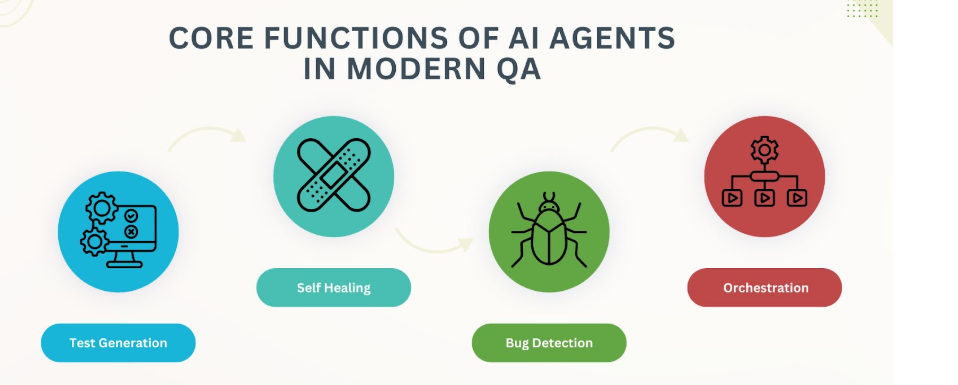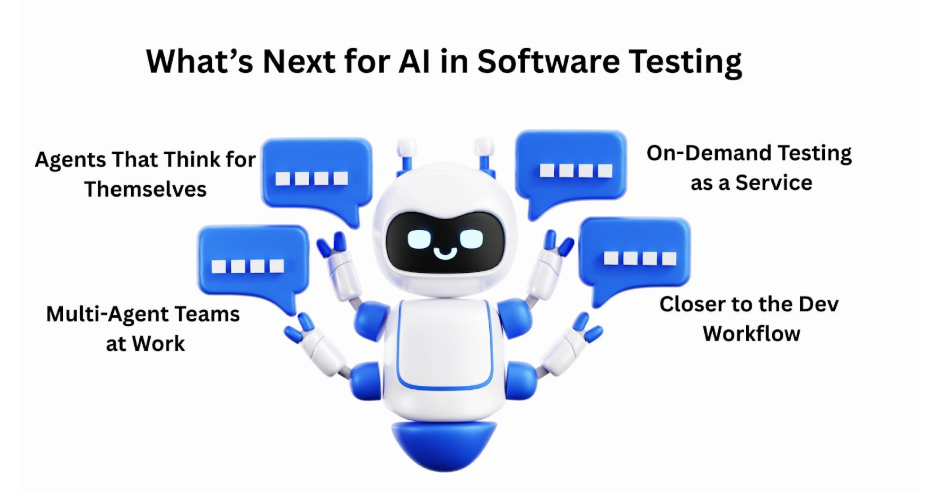How AI Agents Are Transforming Software Testing in 2025
The pace of software development in 2025 is unforgiving. Faster releases, more complex apps, and zero tolerance for bugs. It's a tough balancing act for QA teams.
Automation helped. But now, even automation is falling short.
That’s where AI agents are stepping in not just to automate tasks, but to think, adapt, and act with purpose. Unlike traditional scripts, these agents can analyze code, generate tests, heal themselves, and orchestrate workflows all without needing constant input.
And this isn’t a pipe-dream. Tricentis reports that 80% of software teams expect to be using AI in their testing by next year.
So, what exactly are these agents? What do they do differently? And why are more and more teams saying they’re indispensable? Let’s dive in.
What Are AI Agents and “Agentic AI”?
An AI agent is like a smart teammate that doesn’t need constant supervision. It observes, thinks through what’s going on, and acts all without someone telling it exactly what to do.
That’s very different from old-school automation scripts. Those run the same way every time. If something changes, they usually break. But agents? They adjust. They learn. They figure things out as they go.
This is what people mean when they talk about “agentic AI” — AI that acts on its own, with a goal in mind. It’s not just sitting there waiting for instructions. It’s built to move, make decisions, and help get things done.
Think of it like this: you’re not remote-controlling a robot. You’re working with a system that already understands the job and it’s capable of handling most of it without you hovering over it.
In software testing, this means a few things:
-
Agents notice changes in the code and decide what needs testing
-
They learn from past failures and adjust the test flow
-
And when something looks off, they’ll ask for help instead of crashing or skipping it
It’s not just faster. It’s smarter. And that’s exactly what modern QA needs especially when deadlines are tight and systems change constantly.
From Test Automation to Agentic Testing
Test automation helped teams move faster by catching regressions early. But in today’s fast-moving, code-heavy environments, it’s starting to fall short.
Scripts are fragile. Even small UI changes can break dozens of tests. Maintaining them often takes more effort than writing new ones. And because these scripts follow fixed paths, they miss out when something unexpected happens.
Agentic testing brings in the missing piece: adaptability.
AI agents don’t just execute tests — they make informed decisions. They monitor changes, analyze patterns, and decide what needs to be tested, when, and how. Some even collaborate with other agents to generate tests, prioritize issues, or flag anomalies.
The result is testing that keeps pace with development, instead of slowing it down.
Read More: Learn how DevAssure uses AI to reduce test maintenance and boost insights.
Test Automation vs Agentic Testing
| Aspect | Traditional Automation | Agentic Testing |
|---|---|---|
| Test Creation | Scripted manually or via record-and-playback | Dynamically generated based on code or behavior |
| Adaptability | Static and brittle | Context-aware and self-adjusting |
| Maintenance Effort | High (frequent script updates) | Low (agents adapt to changes) |
| Decision-Making | Follows fixed logic | Makes decisions based on data and goals |
| Collaboration | Isolated scripts | Multi-agent systems working across test layers |
| Learning Over Time | None | Continuously improves through feedback loops |
| Use Case Flexibility | Mostly regression and UI testing | Works across UI, API, performance, and logic layers |
What Can AI Testing Agents Actually Do in 2025?
AI agents aren’t just here to run tests faster. They’re changing how testing works at its core. Here's a closer look at what they’re doing in real-world QA teams right now.

Creating and Updating Test Cases
In the past, someone had to write each test case line by line. Now, AI agents can build test cases on the fly. They look at new code, figure out what’s changed, and create relevant test paths based on that context.
Self-Healing When the App Changes
Minor UI changes used to break tests — not anymore. Agents now detect these shifts and adjust test flows on their own. It’s a big time-saver, especially in fast-moving builds. No human fix needed. This self-healing capability is one of the most practical time-savers in agent-driven testing.
Catching Bugs Early (and Sometimes Predicting Them)
AI agents can proactively analyze patterns in your system to spot where bugs are likely to pop up. By studying code commits, past test failures, and user behavior teams they can identify risk areas before they cause issues.
Orchestrating End-to-End Tests
From APIs to UI to databases, agents can coordinate full test cycles without manual input. They decide the flow, run tests in the right order, and report what matters. It’s testing that keeps up with real-world complexity.
DevAssure is built around intelligent AI agents that integrate directly into your testing workflows. These agents adapt in real time, automating everything from test generation to execution and reporting with minimal human input.
The platform brings all essential testing functions together, allowing agents to handle tasks like data setup, environment monitoring, and performance coordination within a unified system.
By reducing test maintenance and catching issues early, DevAssure helps teams ship faster and with greater confidence.
🚀 See how DevAssure accelerates test automation, improves coverage, and reduces QA effort.
Ready to transform your testing process?
Real-World Benefits for Enterprise Teams
AI agents aren’t just a technical upgrade. For many enterprises, they’re starting to shift how the entire QA function operates and the impact goes beyond faster test cycles.
Fewer Bugs, Less Chaos
One of the biggest wins? Catching issues earlier. When AI agents analyze code changes and system behavior in real-time, they surface problems before they snowball. That means fewer surprises in production, fewer late-night patch releases, and happier users overall.
Teams using agent-based testing have reported noticeable drops in post-release bugs and not just minor UI glitches. We’re talking about logic errors, performance bottlenecks, and security risks that traditional testing might have missed.
Faster Releases, Without Cutting Corners
Speed matters, especially when releases are tied to revenue. AI agents help teams move faster without skipping steps. They decide what needs to be tested and when, freeing up engineers to focus on what’s changing not on test maintenance. In some enterprise setups, teams have shaved days off their release cycle just by letting agents handle the repetitive grunt work.
Lowering QA Costs Over Time
AI-powered tools can feel expensive upfront. But in practice, the cost curve bends in your favor. Teams often spend far less time fixing broken scripts or chasing late-cycle bugs. The usual last-minute QA scramble? That starts to fade. Over time, you see the payoff in both hours saved and headaches avoided.
Helping Teams Work Better Together
AI agents don’t just automate tasks. They help connect the dots between people and systems. By operating across your whole pipeline from code commits to test logs they bring more visibility to everyone involved. Devs and QA teams get on the same page faster, which means fewer missteps and smoother releases.
Want to reduce bugs and speed up releases? Explore DevAssure's test orchestration features. Try it for free.
Getting Started: What Works in the Real World
Bringing AI agents into your workflow isn’t about flipping a switch. The value shows up when they’re rolled out with care. Here are a few practices that have helped teams make the transition smoothly:
Start Small and Build Confidence
Skip the full-blown rollout. Pick one module or workflow and run the AI agent alongside your current test suite. Let it prove its worth without disrupting your flow. You’ll start to see where it helps and where tweaks are needed.
Keep People Involved
Even smart agents need a guiding hand. They’re most useful when paired with experienced testers who can review outputs, make sense of edge cases, and steer the process. The goal isn’t full automation — it’s intelligent collaboration.
Feed It the Right Signals
AI agents learn from what they see. If your logs are messy or test data isn’t clear, their performance can suffer. Before you dive in, it helps to get your environment in order — clean logs, consistent test tagging, and well-structured data flows all go a long way. If you're already working in a CI/CD setup, that's a strong foundation to build on.
Train Teams, Not Just Models
New tools bring new habits. Help your team understand what the agent does, where it helps, and where it still needs a hand. Once testers and developers learn how to collaborate with AI agents, the whole process becomes more fluid and less of a black box.
Key Challenges of Using AI Agents in Testing
Like any powerful technology, AI agents come with their own set of risks. They're smart, fast, and often impressive but they’re not perfect. Here are a few challenges to look out for:
Unpredictable Behavior
AI agents sometimes act in ways you didn’t expect. Maybe they skip a critical test step or prioritize the wrong case. It’s not because they’re broken — it’s because they’re learning from patterns, not strict rules.
Lack of Transparency
It’s hard to trust something you don’t understand. Some AI tools operate like black boxes - they run tests, give you results, but don’t explain how they got there. That’s a problem, especially in regulated environments.
Security and Privacy Concerns
Agents often scan code, analyze logs, and interact with sensitive systems. If your data isn’t well-managed, things can get risky fast especially when testing involves production-like environments.
Over-Reliance
It’s tempting to let the agents handle everything especially when they seem to be doing a good job. But over time, that can create blind spots. Agents aren’t great at context, business logic, or ethics.
That’s why platforms like DevAssure come with built-in explainability logs and human-in-the-loop checkpoints. These features ensure that teams can trace every decision an AI agent makes, review test actions, and step in when needed keeping full control and visibility at every stage of the testing process.
Future Outlook and What’s Ahead
AI agents have already started reshaping how testing works but we’re still in the early stages. What we’re seeing now is just the foundation for something much bigger.

More Autonomy, Smarter Decisions
As large language models continue to improve, agents will get better at understanding intent, code logic, and user behavior. Instead of just reacting to code changes, future agents may begin predicting the kinds of tests needed based on patterns they’ve seen before. Some may even suggest optimizations for the code itself, not just the tests.
Rise of Multi-Agent Collaboration
We’re also going to see more systems where multiple agents work together across the development lifecycle. One might monitor code health, another might generate synthetic test data, and another could flag potential performance risks. These agents will communicate and adapt together, creating smarter, more fluid workflows.
Closer Integration with Developers
The gap between QA and development will likely shrink. AI agents are already starting to embed themselves into IDEs, version control systems, and CI/CD pipelines. As they mature, they’ll become part of the day-to-day workflow for developers — not just testers. Think of agents that review your pull request, run targeted tests, and surface only what actually needs attention.
Testing as a Service, Powered by AI
We’re also watching the rise of plug-and-play AI testing platforms tools that offer testing on demand, without a full in-house QA team. This could open doors for startups and smaller teams to achieve enterprise-grade test coverage with minimal setup.
Conclusion: A Smarter Way Forward
Software testing has always been about one thing: confidence. The confidence that what you’re building won’t break when it matters most. But as systems grow more complex and timelines shrink, that confidence is harder to come by unless your tools evolve with you.
AI agents offer more than automation. They bring intelligence, adaptability, and context into the heart of your testing strategy. This unlocks a new way to test: one that’s faster, leaner, and more resilient.
The shift is already happening. Leading teams are moving beyond static scripts and siloed testing. They’re building QA pipelines that think, respond, and scale with AI agents at the core.
Curious how this could work for your team? Explore how DevAssure brings intelligent agent orchestration into real-world pipelines with less effort and more clarity.
🚀 See how DevAssure accelerates test automation, improves coverage, and reduces QA effort.
Ready to transform your testing process?
